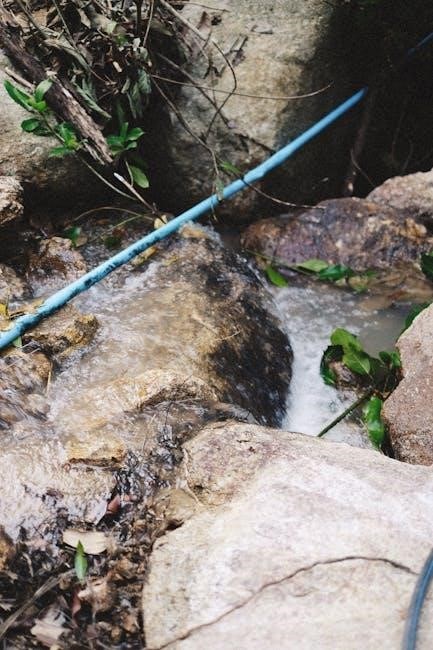Manual pipe and tube benders are essential tools for precision and control in bending pipes and tubes, ideal for plumbing, HVAC, and metal fabrication projects.
1.1 Overview of Manual Pipe and Tube Benders
Manual pipe and tube benders are portable, cost-effective tools designed for bending pipes and tubes with precision. They are ideal for plumbing, HVAC, and metal fabrication projects, offering versatility for various materials like copper, aluminum, and steel. These benders typically allow for bends up to 180 degrees, making them suitable for both small-scale DIY tasks and professional applications. Their ease of use and durability make them essential for creating custom pipe configurations efficiently.
1.2 Importance of Manual Benders in Plumbing and Metalwork
Manual benders are indispensable in plumbing and metalwork for creating precise, custom bends in pipes and tubes. They enable professionals to achieve tight, accurate angles without damaging materials, crucial for maintaining structural integrity and fluid flow in systems. Their portability and ease of use make them ideal for on-site adjustments and repairs, enhancing efficiency and reducing project costs while ensuring high-quality results consistently.

Components and Accessories of a Manual Pipe Bender
Manual pipe benders consist of a sturdy frame, bending dies, and a handle for leverage. Accessories like mandrels and degree wheels enhance precision and control during bends.
2.1 Key Parts of a Manual Pipe Bender
A manual pipe bender typically includes a sturdy frame, bending dies, a handle for leverage, and a degree wheel for precise angle measurement. The frame provides stability, while the dies shape the bend. The handle enables manual force application, and the degree wheel ensures accurate bends. These components work together to facilitate smooth, controlled bending of pipes and tubes, making the tool versatile for various applications.
2.2 Essential Accessories for Optimal Performance
Essential accessories include bending dies, tube holders, and lubricants to ensure smooth operation. Additional tools like packing materials, such as sand, prevent tube deformation. A vise or stand enhances stability during bending, while a protractor helps achieve precise angles. These accessories optimize performance, ensuring accurate and consistent bends while protecting the workpiece from damage.
Choosing the Right Manual Pipe Bender
Choosing the right manual pipe bender involves considering pipe size, material compatibility, and bending capacity. Ensure the tool suits your project needs for optimal results.
3.1 Factors to Consider When Selecting a Bender
When selecting a manual pipe bender, consider the pipe or tube diameter, material type, and desired bending angle. Ensure compatibility with your project’s requirements, and check the tool’s durability and portability. Proper selection enhances efficiency and ensures precise, professional-quality bends for various applications, from plumbing to metal fabrication, while minimizing potential mechanical issues.
3.2 Understanding Bending Capacity and Limitations
Manual pipe benders have specific capacity limits, often up to 2 inches in diameter and 180 degrees of bending. Ensure the tool’s capacity matches your project needs, considering material thickness and type. Exceeding these limits can damage the bender or workpiece. Always adhere to the manufacturer’s specifications for optimal performance and safety, ensuring precise and professional-quality bends without compromising the tool’s longevity or functionality.
Safety Precautions and Best Practices
Always secure the workpiece firmly and wear protective gear. Use a vise for stability and avoid overloading the bender. Follow manual guidelines to ensure safe, controlled bending operations.
4.1 Pre-Operation Safety Measures
Before using a manual pipe and tube bender, ensure the workpiece is securely positioned and free from damage. Wear protective gloves and eyewear to prevent injury from sharp edges or tool movement. Always follow the manufacturer’s guidelines and perform a quick inspection of the bender for proper lubrication and functionality. Ensure the workspace is clear of obstructions and bystanders for safe operation.
4.2 Safety Tips During Bending Operations
Always maintain firm control of the bender’s handles to prevent slipping. Use the correct die size for the tube or pipe to avoid damage or injury. Keep loose clothing and long hair tied back. Avoid using handle extensions, as they can cause loss of control. Ensure the workpiece is securely clamped or held in place to prevent movement during bending. Wear protective gloves and eyewear for added safety.
Maintenance and Care for Longevity
Regularly clean and lubricate moving parts to prevent rust and wear. Store in a dry place to avoid damage and perform routine inspections for optimal performance.
5.1 Cleaning and Lubrication Tips
Regularly clean the bender’s moving parts with a soft cloth and mild detergent to remove dirt and grease. Lubricate hinges and pivot points with silicone-based lubricant to ensure smooth operation. Avoid using harsh chemicals that may damage finishes or components. Proper maintenance extends the tool’s lifespan and maintains its efficiency and accuracy in bending tasks.
5.2 Storage and Regular Inspection
Store the manual pipe bender in a dry, clean environment, away from direct sunlight and moisture; Regularly inspect for wear, corrosion, or damage. Check dies and hinges for alignment and functionality. Replace worn parts promptly to prevent performance issues. Proper storage and inspection ensure the bender remains reliable and ready for use, maintaining its effectiveness over time.
Step-by-Step Guide to Using a Manual Pipe Bender
- Prepare the workpiece by measuring and marking the bend location.
- Set up the bender with the correct die for the tube size.
- Secure the tube firmly in the bending groove.
- Execute the bend by applying steady, controlled force.
- Inspect the bend for accuracy and smoothness post-operation.
6.1 Preparing the Workpiece
Begin by cleaning the tube to remove dirt, oil, or debris. Ensure the surface is smooth and free of obstructions. Measure and mark the desired bend location accurately. Align the mark with the bending die to ensure proper positioning. Secure the tube firmly in the bender’s groove, using a vise if necessary, to maintain stability during the bending process. This step is crucial for achieving precise and consistent results.
6.2 Setting Up the Bender
Loosen the handle and ensure the bending die is aligned with the marked bend location on the tube. Place the tube into the bending groove, securing it firmly with the holding clamp. Adjust the bending die to fit snugly around the tube, ensuring proper alignment. Tighten the handle slightly to hold the tube in place, but not excessively to allow for smooth bending. Double-check the setup before proceeding.
6.3 Executing the Bend
Hold the bender firmly and apply steady, controlled force to the handle, bending the tube gradually to the desired angle. Use a protractor or template to monitor progress. Ensure smooth, consistent pressure to avoid kinking or deforming the tube. Stop when the bend reaches the marked angle, then release the handle slowly. Inspect the bend for accuracy before proceeding.
6.4 Post-Bending Checks
After bending, inspect the tube for accuracy, ensuring it meets the desired angle using a protractor or template. Check for any signs of damage, such as kinks or flattening. Measure the tube’s alignment and verify its fitment with connected components. Address any imperfections promptly to avoid rework and ensure structural integrity. Clean the area to prevent debris interference.
Troubleshooting Common Issues
Common issues include misaligned bends, tube damage, or mechanical malfunctions. Inspect for proper die alignment, check for surface scratches, and ensure the bender is clean and well-lubricated.
7.1 Identifying and Addressing Bent Tube Imperfections
Bent tube imperfections, such as kinks, uneven bends, or surface damage, can compromise structural integrity. Inspect the tube visually for deformities, and measure bends with calibrated tools. Address issues by adjusting die alignment, ensuring proper lubrication, and using appropriate support. For minor flaws, re-bending or filing may suffice, while severely damaged tubes require replacement to maintain safety and functionality in plumbing or metalwork projects.
7.2 Resolving Mechanical Issues with the Bender
Common mechanical issues with manual benders include stuck parts or misalignment; Regular cleaning and lubrication of moving components can prevent malfunctions. Inspect dies and mandrels for wear; replace them if damaged. Ensure the workpiece is securely positioned to avoid slippage. Addressing these issues promptly ensures optimal performance and extends the tool’s lifespan, maintaining reliability in bending operations for consistent results. Always refer to the manual for specific troubleshooting guidance.

Advanced Bending Techniques
Mastering multi-plane and reverse bends enhances precision and control, enabling complex geometries in tubing and piping projects across various industries, from HVAC to custom metal fabrication.
8.1 Multi-Plane Bends
Multi-plane bends involve creating complex angles in different planes, enhancing design flexibility. Using manual benders, users can achieve precise multi-plane bends by adjusting dies and leveraging handle positions. This technique is crucial for intricate piping layouts in HVAC and metal fabrication, ensuring smooth transitions and structural integrity. Regular practice and proper tool maintenance are key to mastering this advanced method.
8.2 Reverse Bends
Reverse bends involve bending a tube or pipe in the opposite direction to create a U-shape or S-shape. This technique is useful for fitting tight spaces and aligning connections. Manual benders achieve this by adjusting the die and applying controlled force. Proper alignment and gradual bending ensure accuracy, making reverse bends ideal for custom plumbing and metalwork projects requiring unique configurations and precise angles.

Applications of Manual Pipe Benders
Manual pipe benders are widely used in plumbing, HVAC, and metal fabrication for creating custom pipe fittings, framework assembly, and repairs, ensuring precise and durable connections.
9.1 Plumbing and HVAC Projects
Manual pipe benders are indispensable in plumbing and HVAC systems for bending pipes up to 180 degrees, ensuring precise connections. They are ideal for copper, steel, and aluminum pipes, making them versatile for installing water supply lines, gas systems, and ductwork. Their portability and cost-effectiveness make them perfect for small to medium projects, providing consistent, professional results in various residential and commercial setups.
9.2 Metal Fabrication and DIY Projects
Manual pipe benders are versatile tools in metal fabrication and DIY projects, enabling precise bending of tubes and pipes up to 180 degrees. They are ideal for creating custom frameworks, artistic designs, and intricate shapes in metalworking. DIY enthusiasts and fabricators rely on these benders for their portability, ease of use, and ability to handle various materials, making them perfect for small-scale, detailed projects requiring accuracy and creativity.
Manual pipe and tube benders are versatile tools for precise bending in various projects, offering portability, ease of use, and cost-effectiveness, essential for both professionals and DIY enthusiasts alike.
10.1 Summary of Key Points
Manual pipe and tube benders are essential tools for precise bending in plumbing, HVAC, and metal fabrication. They offer portability and cost-effectiveness, making them ideal for professionals and DIY enthusiasts. Proper selection, safety precautions, and regular maintenance ensure optimal performance. Following step-by-step guides and troubleshooting tips enhances efficiency. With applications ranging from simple repairs to complex projects, mastering manual benders is a valuable skill for any workshop or job site.
10.2 Final Tips for Mastering Manual Pipe Bending
Always use the correct die size and ensure the workpiece is properly secured. Practice on scrap materials to refine your technique. Keep the bender clean and lubricated for smooth operation. Start with small bends and gradually increase complexity. Consistency and patience are key to achieving precise, professional-quality bends in various applications.